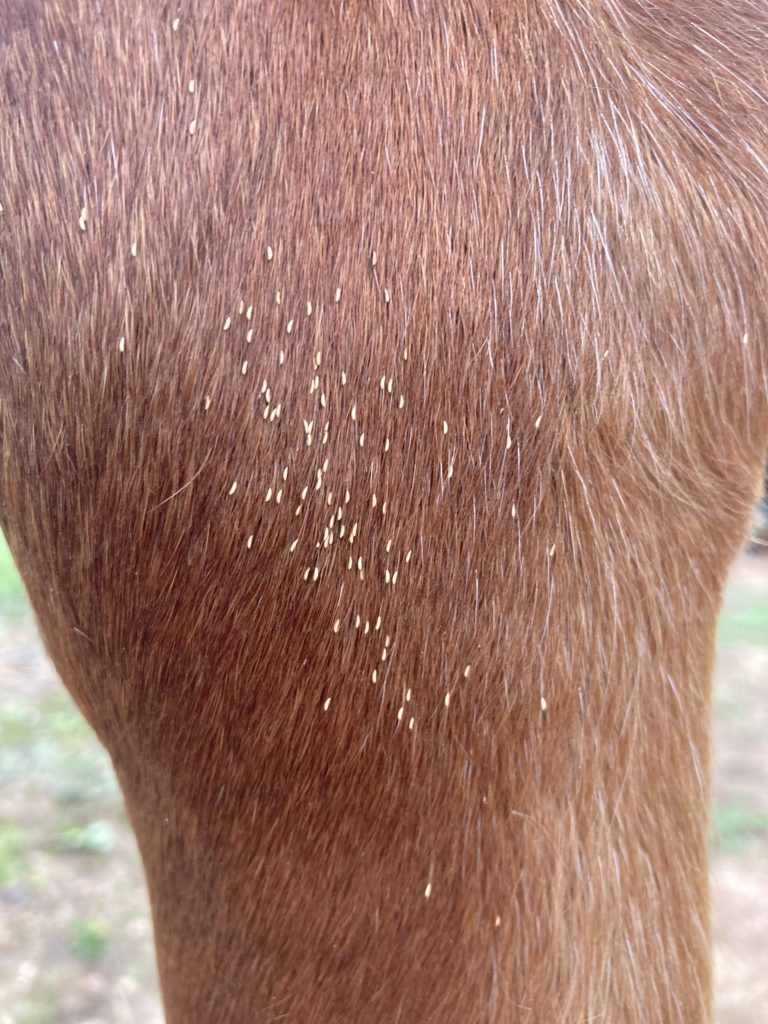Protecting Your Horse from Botflies
go.ncsu.edu/readext?732660
en Español / em Português
El inglés es el idioma de control de esta página. En la medida en que haya algún conflicto entre la traducción al inglés y la traducción, el inglés prevalece.
Al hacer clic en el enlace de traducción se activa un servicio de traducción gratuito para convertir la página al español. Al igual que con cualquier traducción por Internet, la conversión no es sensible al contexto y puede que no traduzca el texto en su significado original. NC State Extension no garantiza la exactitud del texto traducido. Por favor, tenga en cuenta que algunas aplicaciones y/o servicios pueden no funcionar como se espera cuando se traducen.
Português
Inglês é o idioma de controle desta página. Na medida que haja algum conflito entre o texto original em Inglês e a tradução, o Inglês prevalece.
Ao clicar no link de tradução, um serviço gratuito de tradução será ativado para converter a página para o Português. Como em qualquer tradução pela internet, a conversão não é sensivel ao contexto e pode não ocorrer a tradução para o significado orginal. O serviço de Extensão da Carolina do Norte (NC State Extension) não garante a exatidão do texto traduzido. Por favor, observe que algumas funções ou serviços podem não funcionar como esperado após a tradução.
English
English is the controlling language of this page. To the extent there is any conflict between the English text and the translation, English controls.
Clicking on the translation link activates a free translation service to convert the page to Spanish. As with any Internet translation, the conversion is not context-sensitive and may not translate the text to its original meaning. NC State Extension does not guarantee the accuracy of the translated text. Please note that some applications and/or services may not function as expected when translated.
Collapse ▲Heading into fall means the botflies are active again. If you’ve seen small yellow-gray flecks on your horses, then a botfly has visited. These parasitic flies resemble honey bees, and the female can lay 150-500 small eggs in her 7-10 day life cycle. The eggs are usually found around the horse’s front legs, chest, and flanks, but some species of botfly lay eggs around the mouth or throat.

These eggs need moisture and friction to hatch, which is what happens when horses lick at these spots. Eggs laid near the mouth can hatch without any help from the horse. The larvae will burrow in the tissue of the mouth and tongue where they will stay for about three weeks. Afterward, the larvae will migrate to the stomach, where they will attach to the upper, non-glandular portion of the stomach wall. They will stay there for about 9 months before passing out with the manure and pupating in the soil to emerge as an adult botfly. The entire cycle takes about a year, and the adult botflies can be active from late spring to late fall before the first killing frost.
While not the most harmful species of internal parasites, these botfly larvae can cause damage to your horse. The mouth can become painful when the larvae are burrowed there, causing the horse to be unable to eat. They may hurt themselves as they rub their faces against objects in an attempt to relieve the pain. The larvae in the stomach can obstruct the flow of food and create a colic situation and in extreme cases may cause ulcers or perforation of the stomach lining.
Controlling botflies is not very difficult. The key element involves breaking the life cycle. When eggs are observed on your horse, you can sponge warm water with an insecticide over the sites to encourage the eggs to hatch and kill them before they have a chance to infect your horse. Or you can remove the eggs using a specialized serrated botfly knife or grooming stone. Clipping the hair in the area is also an effective method to remove eggs. Eggs only need to incubate for 1-5 days before hatching so removal should be done promptly upon finding eggs.
Administering an anthelmintic, or dewormer, in the late summer and again after the first killing frost will kill the internal larvae and help break the cycle at that stage. Ivermectin and moxidectin have been shown to be effective against botfly larvae.




